
In the early afternoon of May 11, 1964, a Pan Am flight from Honolulu landed on the tarmac at Sydney’s Mascot Airport. On board was famed entertainer Judy Garland, known for her portrayal of Dorothy in The Wizard of Oz and countless other technicolour classics from the golden age of Metro-Goldwyn-Mayer.
Garland was making the first stop on her only Australian tour. Coaxed down under by promoter and entrepreneur Harry M. Miller, she would be paid the equivalent of more than $1 million for three concerts: two in Sydney, one in Melbourne. But the engagement, which began 60 years ago this weekend, would become one of show business’s greatest humiliations.
As the plane doors opened, a frail, tiny Garland descended the aircraft stairway wearing a matching yellow fur-trimmed suit, arm in arm with Mark Herron, a relatively unknown actor whom she would marry the following year. Visibly nervous and tired from a 15-hour flight, she was accompanied by an entourage of nine, including musical director and arranger Mort Lindsay.
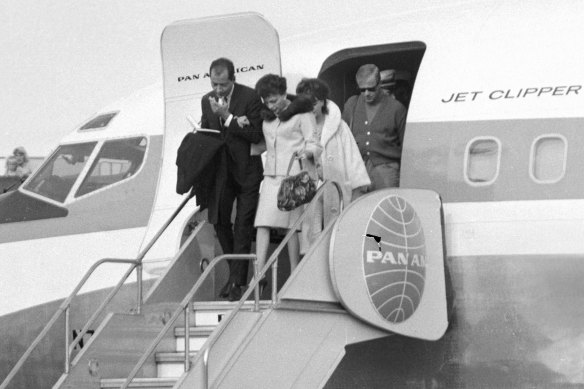
Judy Garland and her entourage arrive at Mascot Airport.Credit: J Manolats
Her arrival was met by hundreds of eager fans and one of the largest assemblies of reporters and cameramen ever to gather at an airport arrival in Sydney to that date.
By 1964, Garland’s temperament and dependency on prescription drugs were already legendary. She relied on a cocktail of barbiturates and amphetamines to survive, let alone tour in a foreign land. On her arrival, customs officials confiscated everything she had, a move that would likely prove fateful.
Garland then faced the Australian press. First, a rushed and disorganised press conference in a hot, cramped room at Mascot Airport. She was officially greeted with a bouquet of flowers presented by Little Pattie (Amphlett), a popular teenage singer known for her appearances on Bandstand, “It was one of the greatest thrills of my life,” Amhplett later recalled.
The press noted Garland appeared “nervous and unhappy” in front of the barrage of television cameras, reporters and fans who had gate crashed the press conference.
Later that evening, Garland attended another lavish press conference at the Chevron Hilton Hotel. Visibly more relaxed, she mingled with 40 reporters and photographers, giving interviews for newspapers, radio and television. “Her eyes are still big and bright, her voice still crisp and her smile still wide – she laughed like a schoolgirl,” noted reporter Ray Castle. Things were going well.
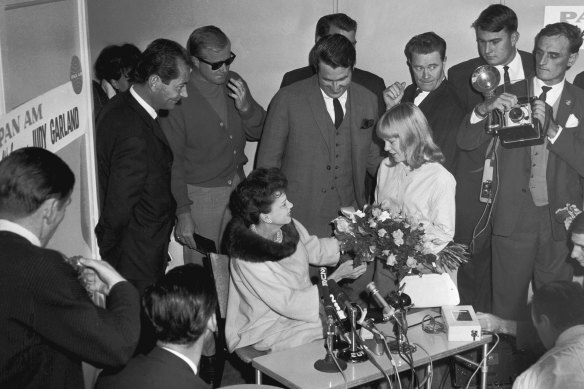
Patricia Amphlett hands Garland a bouquet during her first press conference in Australia. Credit: J Manolats
On May 13, the Australian spotlights were to shine on Judy Garland for the first time at the Sydney Stadium in Rushcutters Bay. Primarily a boxing ring and a totally unsuitable venue for an artist of Garland’s calibre, it was the only venue large enough in Sydney at the time to hold an audience of that scale.
The evening prior, Garland inspected the stage, stage lights and seating conditions of the venue. “I don’t care where I sing as long as people come to see me,” she told reporters asking about her thoughts of performing in a boxing ring. The locker-rooms were turned into a lavish dressing room featuring gold nylon carpet, golden brocade curtains and chandeliers. A special staircase was built to give Garland easier access to the stage.
The atmosphere on the night of Garland’s first performance was exhilarating. A band was hired to play the Garland standards in the park opposite the stadium and Miller had stationed searchlights in front of the venue to crisscross the heavens, “It looked like World War II during the Japanese invasion!” one fan quipped.
The roads were packed for blocks around and the stadium was at capacity, with 10,000 fans waiting to see the entertainer.
When Lindsay initiated the opening notes of the electrifying Garland overture, the audience reacted with immense applause. Once Garland appeared at the back of the stadium, a thunderous roar echoed throughout the “old tin shed”. She made her way down the aisle to the stage wearing a multi-coloured gown with a poppy pattern.
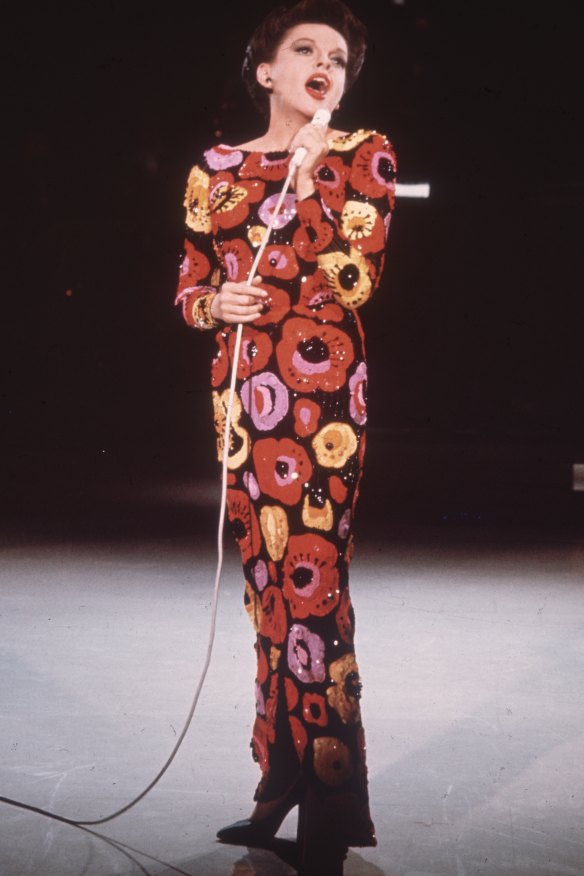
For her first Sydney concert, Garland wore a striking dress with a poppy theme (pictured here from a performance for her US TV show).Credit: Getty
The show consisted mostly of songs from her MGM films, including You Made Me Love You, The Trolley Song and Over the Rainbow. During the first act, she forgot the lyrics to a song and borrowed the sheet music from the band, sprawled it across the stage and got down on her hands and knees to study it. “I can’t read a note of music and I can’t see a thing through these false eyelashes,” she joked.
Garland apologised to the audience for having a frog in her throat, prompting one fan to yell out “It’s Judy Garland. That’s enough!” The show was an incredible success and garnered rave reviews.
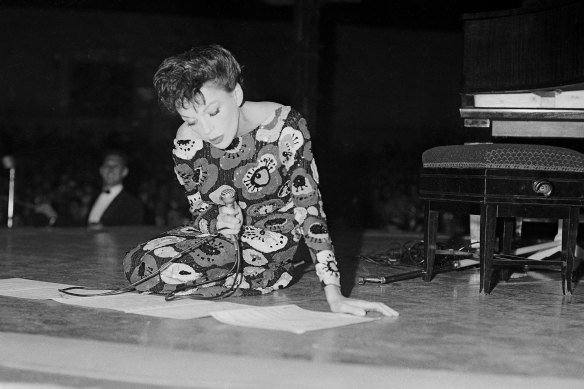
On-stage Garland charmed but backstage the wheels were coming off.Credit: Alan Kemp
Garland remained confined to her hotel suite between her two concerts in Sydney. Rumours suggest it was during this time that she became agitated regarding the confiscation of her medication at customs. As it was clear that she was not going to function without assistance, it is likely Herron organised for replacements to be made in the form of drugs said to be purchased from a Sydney doctor described as “a Chinese abortionist”. What he obtained were doses of drugs much stronger than she was used to.
Garland’s second Sydney show was as successful as the first, rocking the foundations of the stadium with applause. But backstage Garland was unravelling.
Harry M. Miller, over the moon with the success he had made, tried to get her to do a third encore, but she refused, she was tired. “Nothing like this has ever happened in Australia, listen to them!” he pleaded. Herron recounts that his next comment, possibly intended as a compliment, went through her like a bullet. “Only a jerk singer like you could get a reaction like that!” According to Heron: “The whole room went quiet. She held off, then hit him with everything in her.” Miller, who recalled his offence differently, does not dispute the slap: “My ears were ringing.”
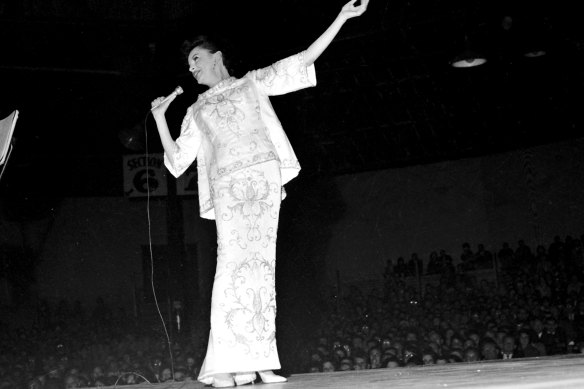
Garland’s second Sydney performance was as successful as the first.Credit: Noel Stubbs
The next hurdle was getting Garland to Melbourne. Garland was afraid of flying, so it was decided that she would travel by rail.
The Southern Aurora was booked and the Garland entourage left Sydney in the evening of May 18, arriving the following morning at 9.10am. She emerged from the platform looking tired, unwell and gaunt. Smothered in white fur, she was greeted by approximately 500 enthusiastic fans and reporters as she made her way to her car. “Miss Garland appeared dazed by the reception but smiled as police cleared a path to her car,” noted The Age. That was all she was going to give the Melbourne press. The press conference was cancelled.
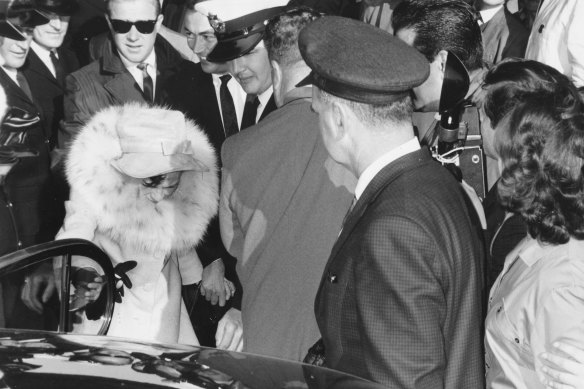
Garland arrived at Spencer Street Station in Melbourne, and cancelled her press conference.Credit: The Age
The evening of Judy Garland’s first and only concert in Melbourne, May 20, came with cancelled rehearsals and refusal to talk to the press. She kept to herself in her suite at the Southern Cross Hotel with a “DO NOT DISTURB” tag hanging on her door.
The show was scheduled to start at 8.30pm. Seven thousand audience members waited patiently at Festival Hall. By 9.30pm, she was still nowhere to be seen. The audience began to slow clap. Garland was still in her hotel suite. She was sick. Miller said, “she was pissed”. It is possible the replacement drugs found in Sydney were not agreeing with her.
Despite her condition, she was finally coaxed out of the hotel, totally oblivious to what was happening at Festival Hall. When she arrived at the venue, she was met with 40 police officers who had been enlisted to manage the angry crowd.
Lindsay started the lengthy overture. Garland took her cue early and wandered onstage midway, arms stretched out and blowing kisses to the audience. She looked frail. “She had a mass of makeup on, but it didn’t cover up the fact that she looked as though she was dying,” one audience member recalled.
Stumbling over a cable upon her entrance, Garland made her way to Lindsay, where she snatched his baton and started to lead the orchestra herself. She was in a daze, poking Lindsay and wrapping the microphone cord around a violinist’s neck. “I just couldn’t get out of that hotel!” she joked with the audience.
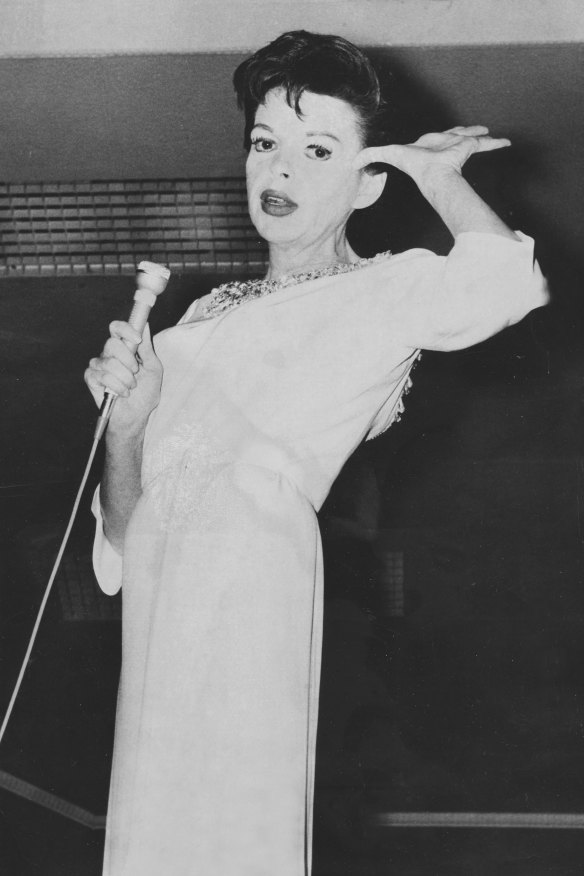
Garland began to lose the audience.Credit: The Age
She began her first number, prompting a barrage of flashes from photographers. “She stopped abruptly, looked sneeringly at the photographers and made a funny pose,” a reporter wrote. Attempting to manoeuvre around the stage in four-inch heels, she knocked over a chair. “You’re drunk!” one heckler exclaimed.
Garland was losing the battle with the audience. Instead of just singing, she clapped back at the hecklers. “Act your age!” one audience member said. “I’m supposed to be temperamental, and I’m being temperamental,” she retorted.
“Have another brandy!” another voice yelled. Some of the audience members began to leave the theatre, to whom Garland yelled: “Where are you going?” “We’re going home, and you should too,” they responded.
After performing for half an hour, Garland left the stage for an interval. She returned to an audience with mixed reactions. Some were deeply saddened by the sight of a woman they had loved so dearly falling apart in front of them. “Give her a chance,” one person yelled. But others were angry and the catcalls and heckles continued.
“This was no problematic, badly behaved diva, just a tired and sick lady trying desperately to fulfil her obligations against all odds, and not well-equipped on how to handle a volatile audience,” Miller’s assistant later recalled.
Garland ended the concert with the haunting By Myself ballad. Halfway through the song she stopped and said, “It’s so lonely by yourself ... goodnight”, and walked off-stage in tears. The episode made headlines across the world. Audience members demanded their money back and the press were ruthless. Even Harry M. Miller turned his back on her. “I will never promote another Judy Garland show anywhere in the world,” he said.

While a crowded jeered, Garland resisted being put on a plane to fly out of Melbourne.Credit: Staff photographer
The following day saw Garland’s management battling the press, dodging accusations of the star being drunk or drugged and fighting to get her out of Australia unscathed. Garland was now refusing to fly to Sydney to catch a plane to Hong Kong. Two flights were booked and then cancelled. As Garland finally left Melbourne on an 8pm flight to Sydney, a mixture of fans and ill-wishers gathered to jeer and hurl insults.
Garland could not fathom what was happening. She was still adamant she did not want to fly, even on the tarmac. “No, no!” she cried, trying to break free after keeping the aircraft waiting for 10 minutes. Her protests would be lost in the roar of the plane’s engines. It took three airline officials and Herron to get her onto the plane.
Once in Sydney again, Garland’s refusal to fly and defiance continued. Locked in her suite in the Chevron Hilton, bookings were made and cancelled to get her out of the country. At 11pm, the Garland entourage climbed the steps to the plane. She made her way across the tarmac, turned for a final wave and, within minutes, Judy Garland disappeared into the night sky.
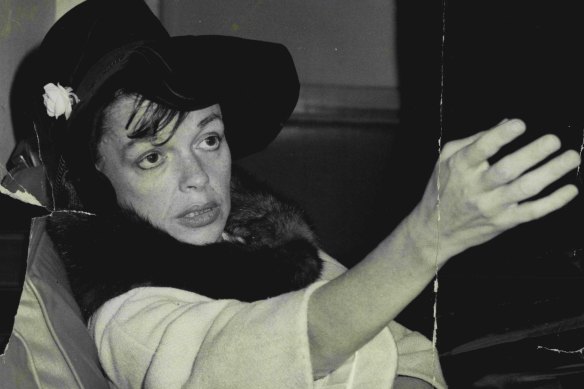
Garland at Kingsford Smith Airport before leaving for Hong Kong.Credit: Fairfax Media
In eleven days, Australia had seen the best and the worst of the woman once dubbed “Miss Show Business”. Garland would suffer a near fatal overdose in Hong Kong. The night before, in her suite at the Mandarin Hotel, she had read Time magazine’s scathing review of her Melbourne performance.
There were comebacks for Garland, but her life declined after her stint in Australia. Five years later, an overdose would eventually kill her at the age of 47 in London.
Start the day with a summary of the day’s most important and interesting stories, analysis and insights. Sign up for our Morning Edition newsletter.









 Add Category
Add Category